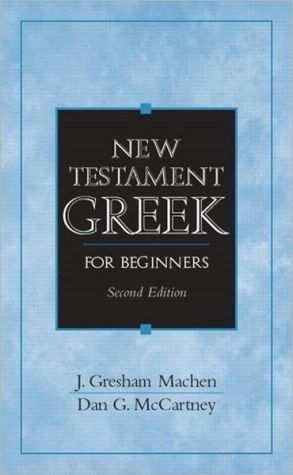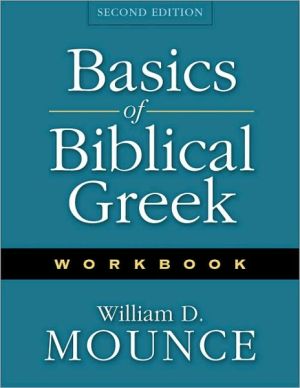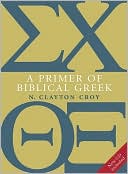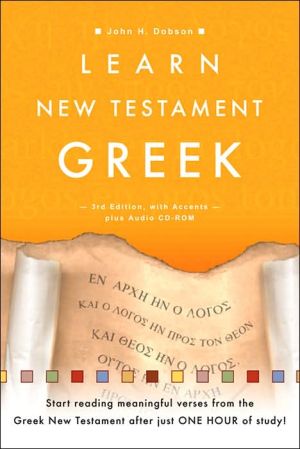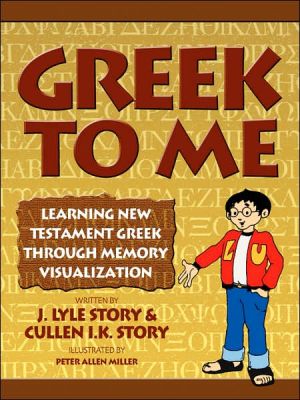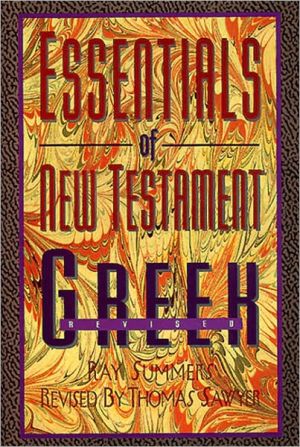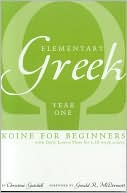New Testament Greek for Beginners
J. Gresham Machen's classic manual for students in biblical studies has been carefully revised and updated by Dan G. McCartney who holds the same academic appointment at Westminster Theological Seminary that Machen himself once held. Students who have no prior understanding of the Greek language will find this new edition eminently readable and valuable in their study of scripture.\ New to This Edition:\ \ Glossary of basic grammatical and linguistic terms—Helps students recognize and...
Search in google:
This book is intended primarily for learners who are beginning the study of the Greek Testament either without any previous acquaintance with the Greek language or with an acquaintance so imperfect that a renewed course of elementary instruction is needed.This revision, over seventy-five years since the first edition was published, retains much of the character and organization of the first edition while accommodating readers today who lack an understanding of Latin and grammar necessary for fully comprehending the original edition.For an introduction to the Greek Testament.
It has been more than eighty years since Dr. Machen produced his classic textbook on New Testament Greek. And yet, as this revision is being prepared, the original edition is still in print. As an unrevised textbook this surely has set some kind of record. A number of reasons might be adduced for this longevity: its clarity of organization, its pedagogical simplicity, its conciseness of presentation and description, its success in dividing and arranging the material, and no doubt its familiarity to three or four generations of New Testament Greek instructors. Yet much has changed since 1923. For one thing, our knowledge of many aspects of New Testament Greek has been considerably refined. Perhaps more important, the educational preparation of students is quite different at the end of the twentieth century than it was at the beginning. Very few students now arrive in class with a solid working knowledge of Latin, and many students do not even have good grounding in English grammar. Rudiments of language that Dr. Machen assumed all students would know can no longer be taken for granted.\ Many instructors have argued that these are good reasons for preparing another grammar entirely and giving Machen's grammar an honored place in a museum, where it may be forgotten. And indeed, criticism of Machen, regarding both content and pedagogical effectiveness, has not been lacking. But surely an alternative is to revise Machen's grammar in light of our present situation, and thus make the effectiveness of this classic available to a new generation.\ This revision is fairly conservative. Since one main advantage of the original is its familiarity, the reviser has tried to retain as much of its character and organization as possible. The following is an outline of the main differences from the original.\ \ Although the lessons and section divisions remain essentially the same, there is a noticeable change in organization in the division of lesson 18 into two parts. Since—as Dr. Machen himself repeatedly stressed—the participle is crucial to understanding New Testament Greek, and since this lesson is usually the most difficult for students, it seemed wise to expand the explanations and illustrations in this lesson. But since lesson 18 was already inordinately long, it seemed best to divide it. In order to keep the lesson numbers in line with the original, the resulting lessons are numbered 18A and 18B.\ Similarly, since the final three lessons cover not only the verbs but also a number of syntactical matters that often lead students to feel somewhat overwhelmed, I have removed some of the syntactical matters of lessons 31-33, along with an additional lesson, numbered 34. This addition, of course, does not alter the numbering of earlier lessons.\ The section numbers are not so easily retained as are the lesson numbers. Some new sections have been added, either to clarify some grammatical matters or to add some material that the original edition overlooked; several sections have been modified to a greater or lesser degree; and occasionally the order of sections has been altered. It was thus impracticable to keep section numbers the same, but for ease of reference the original section numbers (where they correspond) have been included throughout in square brackets . Thus it should be possible for a student to use an old edition of Machen in a class where this new edition is the text, and longtime instructors who have memorized many of the original section numbers will not find it difficult to locate the section they have in mind.\ Since many students may not know the terms of English grammar and syntax, a glossary has been added that defines basic grammatical and linguistic terms.\ A few paradigms and charts have been added both in the text and in the back matter, in particular a list of prepositions and a chart of vowel contractions.\ In the vocabulary section at the end of the book, some unusual verbal principal parts have been cross-referenced to their lexical forms to help students find the correct verb. To supplement the 400 or so vocabulary words introduced in the grammar, most of which appear about 50 times or more in the Greek New Testament, a 250word list provided by Dr. Bruce M. Metzger has been added for words appearing 25-50 times.\ Accents are a frequent bone of contention among Greek instructors. It is the editor's conviction that students ought to learn the accents because they become useful in such matters as marking the contracting verbs and distinguishing progressive from second aorist participles even when the vocabulary item is not known. Furthermore, scholarly literature generally expects accenting to be done properly. But the editor also acknowledges that accents make the difficult task of learning Greek more difficult, with little immediate payoff in ability to read the New Testament. Therefore, although the material on accents has been retained throughout, it is now set off from the main material, except for instances where the accents have some semantic importance.\ Readers familiar with the original edition will note that the term "present" when referring to Greek tense has been changed throughout to "progressive," except when referring to the indicative mood. The reasons for this are explained in a footnote in lesson 18A.\ Few students today have cut their teeth on the King James Bible and Shakespeare, and hence few know how to use correctly the antiquated second person. This edition therefore substitutes, for example, "you (s.)" for each "thee" and "thou" found in Machen's original.\ The only other change worth mentioning here is the move of the vocative case from lesson 4 to lesson 28. Since the vocative is relatively rare and often unpredictable of form when it differs from the nominative, it seemed advisable to treat the vocative as a special case and introduce it with the imperative mood, thus reducing the memorization load in the earlier lessons.\ \ Machen was successful in avoiding some of the linguistic faux pas of his day, and thus, although many other changes have been introduced relating to either pedagogical or linguistic concerns, they do not radically alter the character of Machen's original.\ Many thanks are in order, of course. First, thanks go to my colleagues and mentors at Westminster Seminary. I should also like to thank two of our Ph.D. students, Messrs. John Makujina and Adam Brice, for their suggestions. Further, hearty thanks are expressed to Dr. Bruce M. Metzger for permitting the use of his supplemental word list. Special gratitude is due Mr. Wells Turner for his critical help in various stages of this venture. Finally, I am still, after thirty years, thankful to Mr. Ed Nelson, who first taught me Greek at Gordon-Conwell Seminary, using (of course) Machen's New Testament Greek for Beginners.\ Though it may be doubted whether this grammar can be kept going for another eighty years, it is the reviser's hope that Dr. Machen's wonderful pedagogical accomplishment will minister to at least one more generation of students desirous of reading God's Word in the original languages.\ Dan G. McCartney
Foreword by Moises Silva.Preface to the Revised Edition.Preface to the Original Edition.Introduction.Abbreviations. 1. The Alphabet. 2. Accent. 3. Present Active Indicative. 4. The Second Declension. 5. The First Declension. 6. Adjectives of the First and Second Declension. 7. Masculine Nouns of the First Declension. 8. Personal Pronouns. 9. Adverbs.10. Present Passive and Middle Indicative.11. Imperfect Active Indicative.12. Imperfect Middle and Passive Indicative.13. Future Active and Middle Indicative.14. First Aorist Active and Middle Indicative.15. Second Aorist Active and Middle Indicative.16. Aorist Passive Indicative.17. The Third Declension.18A. Progressive Participles.18B. Attributive Participles.19. Aorist Active and Middle Participles.20. Aorist Passive Participle.21. The Subjunctive Mood.22. The Progressive and Aorist Infinitives.23. Contracting Verbs.24. Future and First Aorist Active and Middle of Liquid Verbs.25. More Nouns of the Third Declension.26. Additional Irregular Declensions.27. Interrogative and Indefinite Pronouns.28. The Imperative Mood.29. The Perfect Tense.30. Comparison of Adjectives.31. Irregular Aorists, and the –mi Verb (part 1).32. Purpose Clauses, and –mi Verbs (part 2).33. –mi Verbs (part 3), and Conditions Contrary to Fact.34. –mi Verbs (part 4),and the Optative Mood.Paradigms.Charts.Glossary.Greek-English Vocabulary.English-Greek Vocabulary.Frequency List (prepared by Professor Bruce M. Metzger).Section Number Correlations.Index.
